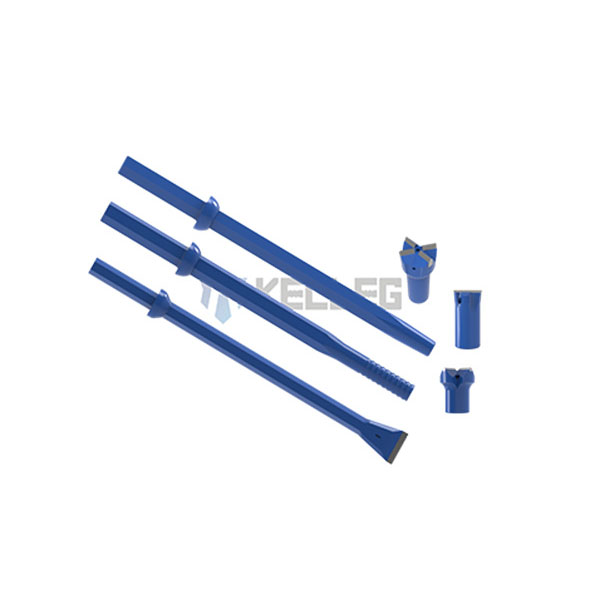2020 官网升级中!现在您访问官网的浏览器设备分辨率宽度低于1280px请使用高分辨率宽度访问。
As people’s demand for safety and efficiency in operation increases, it directly improves people’s safety awareness in related fields. Enterprises in the field of rock drilling and anchoring engineering have been committed to creating safer and more efficient solutions, such as rock drilling tools that are widely used in mining, hydropower, tunnels, culverts, subways, municipal construction, and other geotechnical engineering fields. It directly affects the development of rock drilling engineering.

As we all know, there are many kinds of rock drilling tools, including top hammer rock drilling tools, down-the-hole rock drilling tools, rotary rock drilling tools, scraping rock drilling tools, roller cone rock drilling tools, and shield drilling tools. (You can directly visit“What are the types of rock drilling tools” to view.) Therefore, in different construction environments, we need to choose different rock drilling tools. To produce high-quality rock drilling tools, first of all, in the selection of raw materials, manufacturers need to select high-quality steel and cemented carbide, and other materials and then need to use advanced production technology and production equipment. Of course, Experienced works in the drilling industry are also very important. That is to say, these series of processes are called production processes, so what is the production process of rock drilling tools? We give you a simple share.
1. Raw materials
The quality performance evaluation of rock drilling tools generally needs to consider wear resistance, corrosion resistance, and fatigue resistance. Therefore, the basic requirements of steel for rock drilling tools are high strength, high toughness, wear resistance, corrosion resistance, and high impact fatigue performance. The raw materials of rock drilling tools we choose generally include steel, cemented carbide for rock drilling, solder, etc.
2. Hot-working
Hot-working is a processing method that simultaneously produces plastic deformation and recrystallization of metal materials under conditions higher than the recrystallization temperature. Hot-working usually includes casting, forging, welding, heat treatment, and other processes.
3. Cold working
In metal technology, cold working refers to the process of plastic deformation of metal below the recrystallization temperature, such as cold rolling, cold drawing, cold forging, stamping, cold extrusion, etc. The cold working deformation resistance is large, So it can improve the hardness and strength of the products while forming.
4. Heat treatment
Heat treatment refers to a metal thermal processing process to obtain the expected structure and properties through heating, heat preservation, and cooling while the material is in a solid-state.
5. Anticorrosion
Anticorrosion is to take various means to protect metal objects that are easy to corrode and to extend their service life. Usually, chemical anticorrosion, physical anticorrosion, electrochemical anticorrosion, and other methods are used.
6. Strengthening and other processes
The scientific rigor of the production process of rock drilling tools directly determines its quality. From what we mentioned above about the wide variety of rock drilling tools, it can be seen that rock drill bits and rods are the most common products in daily operations, so let’s expand and share the production process of rock drill bits and drill rods.
The production process of rock drilling bit: raw steel blanking – forging forming – machining – heat treatment – machining – cemented carbide insert.
The production process of rock drilling bit: raw steel blanking – forging forming – machining – heat treatment – machining – cemented carbide insert.
At present, there are two main types of drill rod materials, one is the drill rod material without carburizing treatment, only heat treatment, such as 55SiMnMo, etc.; One is the need for carburizing treatment, the selected material is generally carburizing carbon steel, typical of 27SiMnNi2CrMo(FF710), (18~23)CrNi3Mo, etc. Another is for heave drill rods: hollow bar stock – blanking – machining – carburizing – heat treatment.
Therefore, to meet the market demand, there are some companies specializing in the production of drill bits and drill tools, such as Sandvik, AtlasCopco, etc.
After years of development, the rock drilling tool industry has made great achievements, but the other brands in the market are still far greater than the dominant brands, which has caused these brands to have the same service life as the international ones in terms of the service life of rock drilling tools. There is still a gap between the dominant brands. However, with the growth of people’s demand for rock drilling tools, most companies will inevitably conduct research and innovation on different demand points to continue to meet the market. In addition to the research in the production process of rock drilling tools, rock drilling tool manufacturers need to continuously and timely pay attention to market changes, pay attention to changes in geotechnical construction technology, blasting technology, and rock drilling machinery. The construction plan provides users with competitive and differentiated products. In this process, enterprises must have innovative thinking. Only in this way can they stand out in the fierce market competition.